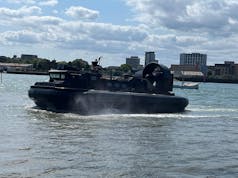The MoD has announced a £201 million package to support further design work for the Successor nuclear submarines.
The funding will enable BAE Systems to develop the design of the submarine, including the layout of equipment and systems, and to develop manufacturing processes, including the production of early prototypes. The announcement comes ahead of the next phase of the programme later this year.
BAE will be the lead contractor on the project and expects to have between 5,000 and 6,000 people working on the programme at its peak, out of a total of about 9,000 people in the unit at the time. BAE’s submarine business currently employs 7,700 staff, with the bulk of them working on the Astute-class attack submarines.
Tony Johns, managing director of BAE’s submarines division, said:
“We are incredibly proud of the role we play in designing and building our nation’s submarines. The Successor programme is one of the most challenging engineering projects in the world today and this additional funding will enable us to further mature the design.”
Defence Secretary Michael Fallon said:
“The round the clock nuclear deterrent is as crucial to Britain’s national security now as it has ever been. We use it everyday to deter extreme threats that cannot be countered by any other means.
When there are 17,000 nuclear weapons in the world, we can’t wish away threats we face now and those that may emerge in the 2030s, 2040s, and 2050s.”
The funding, is part of the overall £3.3 billion package announced in the last parliament for the Assessment Phase of the Successor submarine programme. Four Vanguard submarines – which currently maintain the UK’s nuclear deterrent – will be replaced from the early 2030s.
It’s expected that the Successor submarines and their infrastructure will cost around £15 billion. This can be broken down as such:
- £0.25 billion to participate in the Trident D5 missile life extension programme.
- £11 billion for a class of four new submarines.
- £2 billion for possible refurbishing of the warheads.
- £2–3 billion for infrastructure (spent over 30 years).
There would be savings from a three-boat solution but these would not be in proportion to the reduction in the number of submarines.
“Of course, the deterrent is not cheap – no major equipment programme is. But our current nuclear weapons capability costs on average around 5-6 per cent of the current defence budget.” David Cameron, the Telegraph, 4 April 2013
According to a series of statements made in Parliament by ministers of the MoD, the annual operating costs of the Trident programme will indeed be around 5 to 6 per cent of the defence budget.
This means that the replacement submarines will have a running cost of around £2 billion per year, that may seem high but in defence terms, it’s relatively low as a single Type 45 Destroyer costs close to £1 billion to purchase let alone operate and fully arm.
The current annual spend on Trident is equivalent to less than 1 per cent of current health and education expenditure, this figure will be roughly the same for the replacement. The MoD also confirmed last year that once the new nuclear deterrent submarine comes into service, the “in-service costs of the UK’s nuclear deterrent, including the costs of the Atomic Weapons Establishment, will be similar to today”, at around 5-6% of the defence budget, between £2 to £2.4 billion.
So is the cost of Trident less than 1.5% of our annual benefits bill as the Prime Minister said?
Benefits expenditure by the Department for Work and Pensions for the financial year 2011/12 was £158.5 billion. That figure includes £74 billion of state pension but does not include Child Benefit which is dealt with by the taxman, who gave people £12 billion in 2011/12.
1.5% of that bill roughly totals £2.38 billion, the figures cited by the Prime Minister seem sound, although they’re not set in stone as the programme has barely started. Estimates of the long term costs of big capital spends are notoriously hard to predict and can often fall or rise drastically. The costs associated with the programme are comparable to the procurement costs of major weapons systems such as Typhoon or Lightning aircraft.
Assuming the new submarines have a service life of 30 years, how much will it cost to run the submarines over their lifespan? Around £60 Billion spread over 30 years. When the initial procurement costs are added on, the total programme cost will an estimated £75 billion however, £60 billion of this figure, as mentioned earlier, is spread over the lifetime of the vessels.













BAE? So we’re not hoping for it to be on time and within budget then…
It does wind me up that we have to justify and break down the costs of the trident programme…
Of course its not a bargain, no one should be fooled into thinking otherwise. Of course it costs a lot. Delving into comparative costs against other government departments is great but completely misses the point and the argument of why we need trident, and our needs for trident are not financial. It all falls within the defence budget assigned by government, which is 2% of the annual budget and for the average Joe that should be enough…
No one has these arguments for the costs of the RAF using Brimstone weapons or the costs for updating Typhoon jet aircraft to use the accurate, collateral damage limiting Brimstone weapons. So why bring it for trident? They must have little reasons to doubt our need for trident in that case…
A) Who else? B) Keep politicians sticky hands away from the contract then.
Good on BAE – some good work being done
Until Liebour cancel it along with Trident.
Yes I will